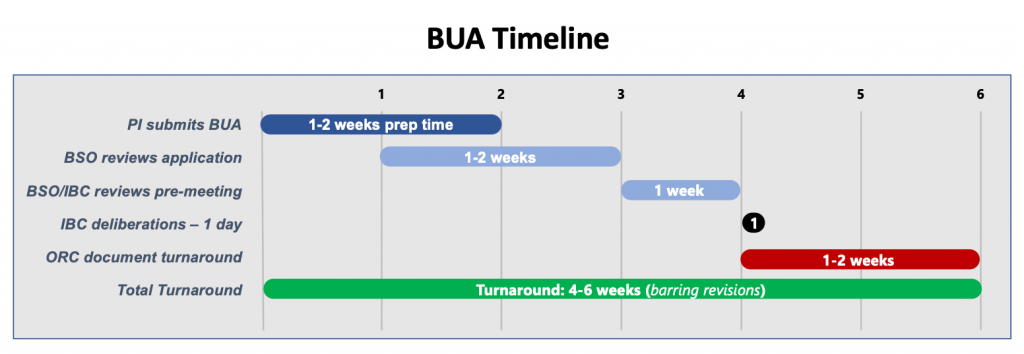Project Registration
It is the policy of The University of Alabama to have all work involving biological material as well as all work involving recombinant or synthetic DNA reviewed by the Institutional Biosafety Committee (IBC). Approval must be granted before work begins.
To submit a project or protocol for review, please complete a Biological Use Authorization (BUA) Form.
If a protocol needs to be closed, please submit an IBC Protocol Closure Form.
To submit a Minor Amendment to an existing IBC protocol, submit a Minor Amendment.

TIMELINE
Total turnaround (barring revisions) is approximately 4-6 weeks (barring revisions):
- PI Submits BUA – 1-2 weeks prep time
- BSO reviews application – 1-2 weeks
- BSO/IBC reviews pre-meeting – 1 week
- IBC deliberations – 1 day
- OREC document turnaround – 1-2 weeks

A BUA IS REQUIRED FOR THE FOLLOWING:
- Projects that utilize Recombinant or Synthetic Nucleic acids.
- Projects utilizing potentially pathogenic materials/organisms, including those that are considered hazardous to humans, animals, agriculture, and the environment.
- Projects that will import biological/botanical samples internationally.
- Projects categorized as Risk Group 1 or 2. (BMBL 6th ed.)
- Projects that are currently not funded, or are categorized as ‘Start-Up’ funding, especially federally funded projects.
Application Review
EACH SUBMISSION
- Must be received by the 1st of the month to be considered for the next IBC meeting. IBC meetings are scheduled on the first Tuesday of the following month (Please see the schedule).
- BUA must be complete, including supporting documentation, permits, and SOPs. BUAs may accompany IRB or IACUC protocol submissions.
- If the submission is complete and deemed fully eligible for IBC review by the BSO, it will be posted to the next meeting’s agenda. Incomplete submissions will be returned to the applicant for revisions.
THE BSO REVIEWS APPLICATIONS FOR THE FOLLOWING:
- The title of the project must match any corresponding IRB or IACUC protocols.
- SOPs attached and current.
- The project abstract is written in plain language. It should be clear, concise, organized, and appropriate for the intended audience. (Community members sit on the IBC)
- Exposure Control Plan (Bloodborne Pathogens).
- Permits/MTAs attached
TIMELINE
Preliminary application review will take approximately 1-2 weeks.
Risk Assessment
Project risk assessment is initially performed by the PI. Following BUA submission, the BSO will perform a full Risk Assessment.
- Determine Category, Risk Group, and Containment level.
- Category A: Containment level 1 based on NIH Guidelines; BMBL; and/or established guidelines plus additional project-specific considerations.
- Category B: Containment levels 1 & 2 include proposals for recombinant or synthetic nucleic acids (r/sNA) covered by NIH Guidelines and/or other biohazards or pathogens requiring BSL-1 or BSL-2.
- Are additional containment practices needed?
- Full inspection of Lab space and equipment.
- Is Occupational health surveillance requested?
- Evaluate the experience and training of all researchers listed on BUA. (training certificates)
The BSO then utilizes the BSO/IBC review flowchart to determine what the path of review will be.
TIMELINE:
- BSO/IBC reviews pre-meeting – 1 week
- IBC deliberations – 1 day
- OREC document turnaround – 1-2 weeks
Monitoring & Reporting
POST-APPROVAL MONITORING (PI, BSO, EHS, ORC)
- PI is responsible for submitting an updated inventory and self-audit of the lab annually.
- Once the rDNA protocol is approved, the lab becomes eligible for random compliance inspections by the BSO.
- BSO performs and documents random inspections of labs with approved BUAs yearly.
REPORTING IS ONGOING FOR THE LIFE OF THE AUTHORIZATION
- IBC receives written results of lab inspections at regularly scheduled meetings.
- PI receives written notification of results of lab inspection and submits response to corrective actions.
- OREC submits NIH OSP notification if required.
- OREC submits an annual report to OSP.
When completing forms, examine all biological hazards associated with the proposed work. Consider how the associated risks will be minimized. The IBC will review your forms.
- Please only complete those sections that are pertinent to your research project.
- Please make sure that all personnel has proper training. (only list those who will actively participate in the study).
- If there is an IACUC or IRB associated with the BUA, please make sure that the title of the study matches those protocols.
- Be sure to attach the following to your BUA under the ‘Hazard Control’ section. (If you require more than 3 files to be attached, consider combining multiple pdfs into one continuous file and then upload as one file).
- SOPs; Shipping and Transport SOPs
- Exposure Control Plans for your lab
- Emergency protocols and infection control policies for your lab
- Vector maps
- Materials certifications
- Material Transfer Agreements
- Permits (domestic or international)
- Equipment decontamination SOPs from the manufacturer
- Note: Formstack will allow you to save the document as you go (partial submission), however, before you SUBMIT, you will need to re-attach files; re-check the Appendix A box at the end of the form, and sign the form again. It is recommended that you do these just before you are ready to submit.
- Successful submission will be accompanied by an Email confirmation to the BSO and the PI. Note: if you would like a pdf copy of the completed BUA, please email that request to biosafety@ua.edu.
Amendments to submitted or approved BUAs can be made by email to the BSO and must be accompanied by the assigned BUA # (ex. 20-123-IBC) in addition to detailed changes requested.
Biosafety SOP Template & Guidance
A list of all forms related to Biosafety can be found on ORED’s Forms page.
TIMELINE
The committee recommends planning 1-2 weeks for preparing a BUA submission.
Institutional Biological Safety Committee (IBC)
The University of Alabama has an institutional biological safety program established to ensure that all research, testing, and teaching activities involving the use of biohazardous materials, and the facilities used to conduct such work, remain compliant with all external regulations and applicable university policies.
The Institutional Biological Safety Committee (IBC) was established in order to conform to NIH Guidelines (2024). The IBC is now involved in the oversight of all projects involving infectious agents and recombinant DNA (rDNA).
Responsibilities
- to review the use of Risk Group 1 (RG1) and RG2 biohazardous agents;
- to review and approve the use of select agents and recombinant DNA (NIH Guidelines);
- to review the Biological Safety Program annually to determine if the program is effective and compliant with regulations;
- to advise the Institutional Biological Safety Officer (IBSO) and support the biological safety program;
- to assist the IBSO with enforcement of regulations and guidelines; and
- to advise the Vice President for Research.
IBC Meetings (revised schedule Fall 2024) are scheduled on the first Tuesday of the month unless otherwise arranged.
IBC Meetings 2025
